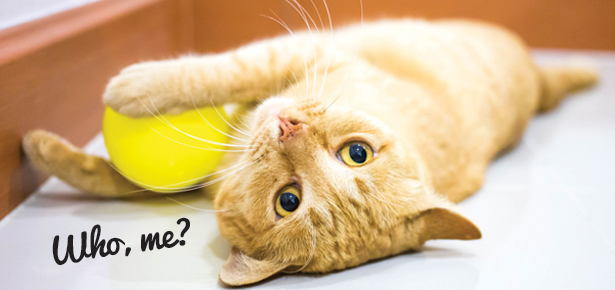

Your Hairball Survival Kit
Help for handling this hairy phenomenon
Hairballs are a natural outcome of your cat’s fastidious grooming routine, but that doesn’t mean you love cleaning them up! To help with the woes of hairball control, we’ve rounded up a selection of essentials to reduce hairball frequency, as well as cleaning products for when the inevitable happens.
One of the best ways to cope with hairballs is to reduce their occurrence. What you feed your cat can make a big difference. Wellness Pet’s Natural Hairball Control cat food, for example, helps prevent hairballs by nourishing the skin and coat (less loose hair to swallow) and contains a fiber blend designed to move hair through your cat’s digestive system. Getting your cats to eat it couldn’t be easier—enticing meat flavours will have them chomping at the bit!
The hairball control treats from Pet Naturals of Vermont are not only super-tasty (irresistible chicken flavour!), they also promote healthy skin, coat, urinary tract, and good digestion, reducing hairball formation. In other words, less icky hairball messes for you to clean up and more happy cats!
CocoTherapy Cat Hairball Plus is made with only one ingredient—high-fiber organic coconut—to help cats pass hairballs more easily by adding moisture and bulk to their stool. It also supports healthy skin and coat (less shedding!) as well as digestive health and gastrointestinal tract function, thereby preventing hairball formation.
Grooming tools that remove excess and loose hair, like the Andis Deshedding Tool, are your best friend in hairball prevention. The Andis Deshedder reaches beneath your cat’s longer topcoat to gently remove undercoat and loose hair—purrfect! (Bonus: less cat hair on your couch!)
Regular brushing combined with a hairball control shampoo is also a solid line of defense against hairballs. Oster’s natural Oatmeal shampoo is safe for your cat and contains a cleansing aloe to improve your cat’s skin and coat.
Despite your best efforts, hairballs can still happen. On those rare occasions, Anti-Icky-Poo’s odour removing spray cleans up the mess with a pet-safe blend of live bacteria and enzymes that doesn’t mask odours, but works quickly to neutralize them. Hairballs might not be pretty, but dealing with them is a lot less tedious with these problem-solving products!
What are hairballs?
Hairballs are the natural result of your cat grooming herself and swallowing hair in the process. (Longhaired cats are more prone to hairballs but all cats can experience them.) A cat’s digestive system is generally able to process the hair and, ideally, it simply passes through the intestinal tract, emerging in your cat’s feces. Sometimes, however, a tubular mass of hair is vomited instead, which is what is commonly referred to as “coughing up a hairball” (ew).
Join the newsletter and never miss out on cat content again!
"*" indicates required fields
By clicking the arrow, you agree to our web Terms of Use and Privacy & Cookie Policy. Easy unsubscribe links are provided in every email.




